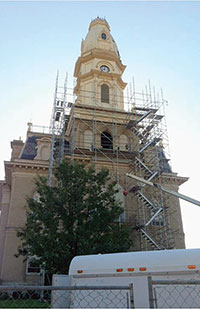Updates Approved to Judicial Emergency Rules

Wind storm damage to the Logan County Courthouse caused an Ohio Supreme Court committee to examine if court rules adequately addressed how to handle judicial emergencies and the temporary relocation of courts.

Wind storm damage to the Logan County Courthouse caused an Ohio Supreme Court committee to examine if court rules adequately addressed how to handle judicial emergencies and the temporary relocation of courts.
The Supreme Court of Ohio today announced changes to rules that can help local courts deal with emergencies.
The current Rule 14 of the Rules of Superintendence for the Courts of Ohio has essentially remained unchanged since it was originally enacted in 1971.
The changes approved by the Supreme Court provide clarity as to the Chief Justice’s duties and responsibilities during a judicial emergency, and include requiring the Chief Justice to:
- Issue an order declaring a judicial emergency and setting forth basic information such as the name of the affected court or division, a description of the circumstances necessitating the declaration, the duration of the judicial emergency (which is initially limited to 30 days), and any other relevant information.
- File the order declaring a judicial emergency with the Clerk of the Supreme Court and, if possible, the clerk of the affected court or division.
- Consult with the administrative judge and court administrator of the affected court or division prior to taking action during a judicial emergency.
The Supreme Court Advisory Committee on Court Security made the proposals after questions arose from emergency-related events, such as the 2012 wind storm that closed the Logan County Courthouse, and whether current Ohio law and court rules adequately address such emergencies. The amendments were published earlier this year for public comment and were presented to the court without revisions.
The rule amendments take effect on January 1, 2015.


